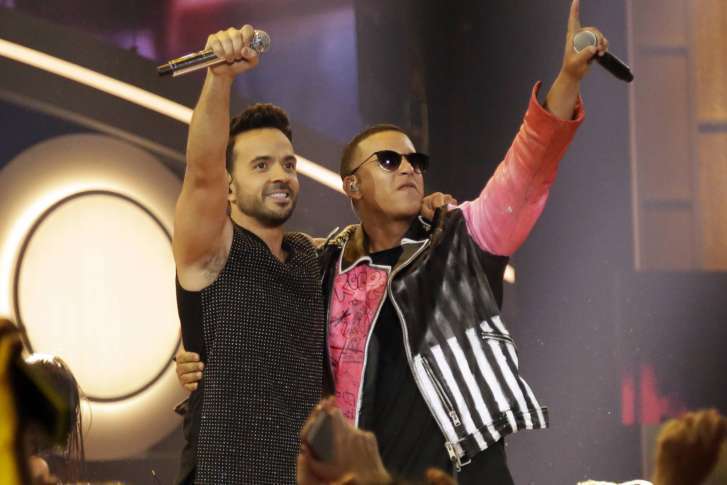The Oscars flub, the release of “Wonder Woman,” Prince Harry and Meghan Markle’s royal engagement and Beyoncé’s pregnancy announcement are just a few of the biggest moments in 2017 pop culture. While all of these moments had their share of buzz in the media at the time of their occurrence, there was one that remained popular for the entirety of the year: Luis Fonsi and Daddy Yankee’s remix of “Despacito.”
When Luis Fonsi released the original version of “Despacito” featuring Daddy Yankee, it was an instant hit among the Latino community, but once Justin Bieber joined for a Spanglish remix, the track’s popularity grew to unprecedented heights. One of its most notable accomplishments is topping Billboard’s Hot 100 chart at No.1, making it the first Spanish song to do so since 1996 with the release of “Macarena.”
Upon its release, the track broke numerous records, such as becoming the longest-reigning number one on the Billboard Hot 100, the longest-reigning number one on the Billboard Hot Latin Songs chart and the most viewed music video of all time on YouTube.
Of course, with such incredible achievements, it made sense for other artists in the music industry to want a taste of the success by releasing bilingual collaborations of their own.
Not too long after, J Balvin and Willy Williams released a remix of their hit, “Mi Gente,” featuring Beyoncé. Similar to “Despacito,” the original had entirely Spanish lyrics, but the remix included a blend of both Spanish and English.
Other releases followed the same format, including Latin boy band CNCO’s remix of “Reggaetón Lento” with British girl group Little Mix and Post Malone’s remix of “Rockstar” with Nicky Jam and Ozuna.
Although all of these collaborations were successful in their own way, none of them reached the heights that “Despacito” did when it first released. Even Luis Fonsi, who helped write the viral hit, tried to recreate that same success with “Echame La Culpa,” a Spanglish track featuring Demi Lovato.
Currently, a year after the song’s release, the trend of bilingual collaborations has not faded but has grown. Most recently, former One Direction member Liam Payne worked with J Balvin on the Spanish track “Familiar,” but unlike other recent bilingual crossovers in the past year, “Familiar” has mainly English lyrics and does not include Spanish in the chorus of the song but instead in the bridge.
Before “Despacito,” this was how many bilingual collaborations worked. Most would contain primarily English lyrics with only a dash of Spanish lyrics scattered throughout the song.
However, after the popularity of the Luis Fonsi track, which contained primarily Spanish lyrics, artists in the music industry saw that one of the characteristics that made the track so popular was that it didn’t focus on English. For the first time, mainstream artists were putting a language other than English at the forefront.
At the time of its release, the track was a refreshing taste from the other songs on the radio because of its combination of Latin rhythms, artists and lyrics. This made it different from other mainstream songs that included primarily white singers and groups. Additionally, instead of having an English-speaking artist featuring a Spanish-speaking one, it was the other way around, giving the authority to Latino artists.
The track didn’t just inspire bilingual collaborations in the United States either because just a few weeks ago, K-Pop group Super Junior released a Korean-Spanish collaboration with Leslie Grace for their new single “Lo Siento.” Even though the track belongs to a non-Spanish-speaking artist, it includes a lot of Spanish lyrics, both in the chorus and the verses.
Since its release, the song has been dominating iTunes’s K-Pop charts, as well as Spotify’s K-Pop and Global charts, aided by Super Junior’s recent performances of the song across South Korea and Latin America as part of their comeback.
Although other bilingual collaborations didn’t receive as much success as “Despacito” in the United States, “Lo Siento” was able to become successful with audiences in South Korea because Korean-Spanish crossovers are not as common.
Since the song also includes bits of English scattered throughout, some even consider it to be a trilingual endeavor. Again, the spontaneous release was something different for music listeners, and that is what is making new songs so successful.
Additionally, these projects gain a high amount of recognition because they draw in different audiences. Instead of focusing on a single demographic, the artist is appealing to several. For example, “Reggaetón Lento” attracted CNCO’s primarily Latin fan base and Little Mix’s British fan base, while simultaneously appealing to their fans of other countries. This, in turn, encourages different cultures to come together for a shared love of music.
The singles also include bits of influences of all cultures involved, from their lyrics, to their music, to their choreography. By combining all of the elements, the result is something entirely new.
However, because many songs in the United States are attempting to recreate the formula used by “Despacito,” the projects end up losing the excitement and spontaneity to music listeners, resulting in these crossovers not reaching the amount of recognition that their artists intended to.
Since Super Junior’s “Lo Siento” released outside of the United States — where many of these Spanish and English crossovers have been occurring — the single was able to achieve great success, especially because it involved two languages that spanned across different continents and thousands of miles away from each other, something uncommon in the music industry.
So, what’s next?
Since there have been many musical projects that included Spanish and English crossovers, music listeners like myself are eager to see what trend will take over the music industry next.
As the industry has seen in the past few months, the K-Pop music genre has been blowing up in the United States with the success of BTS, and it will only continue to get more popular as the group takes the stage at the 2018 Billboard Music Awards in a few weeks. So, if you were to ask me, I’d say get ready because the world is about to see a new trend take over the music industry, and that is K-Pop.
















